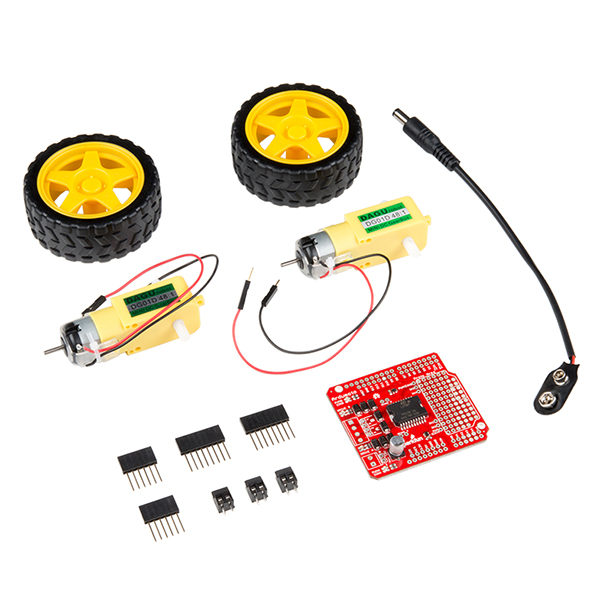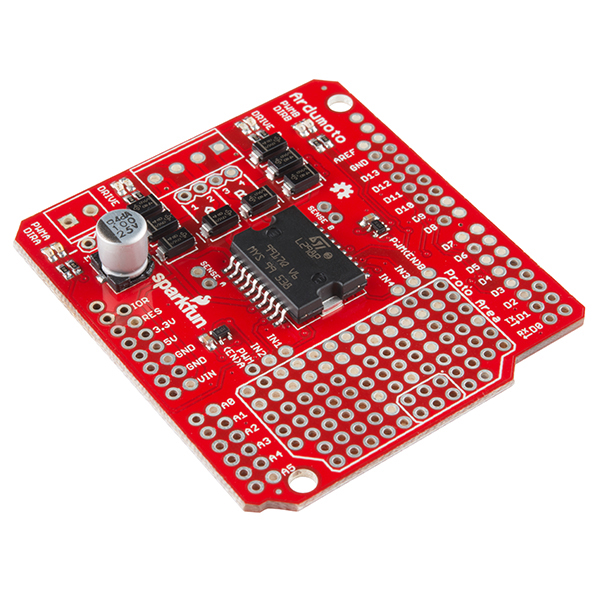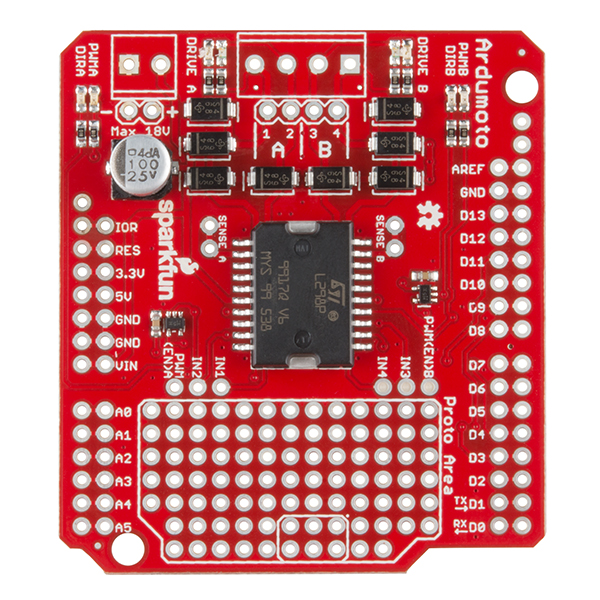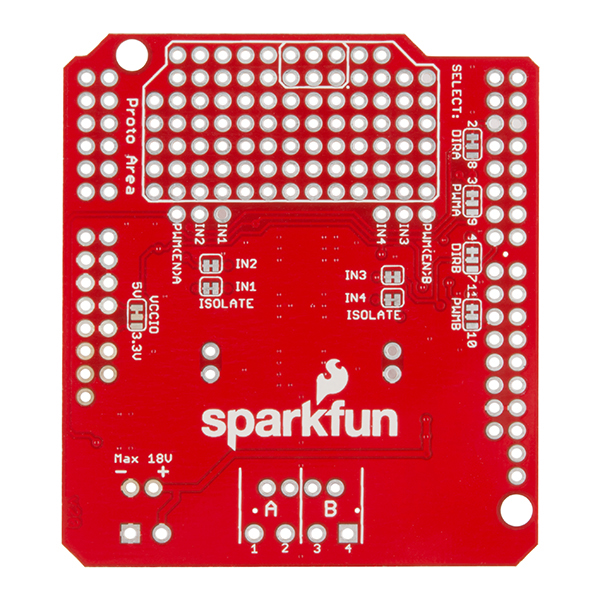SparkFun Ardumoto Shield Kit
Robots are fun, and Arduinos are easy. So wouldn't it be nice if there were a kit that included everything you need to get your Arduino device set up to control a simple two-motor-circuit buddy? The SparkFun Ardumoto Shield Kit is perfect for any robot enthusiast and includes an Ardumoto Shield, as well as pairs of tires, motors, connectors and wires. And, of course, it’s all stuffed in a classic SparkFun red box (which may come in handy as a robot chassis).
The Ardumoto Shield is an easy-to-use dual-motor controller for Arduino. Combined with an Arduino, the Ardumoto makes a fantastic controller platform for RC vehicles or even small autonomous robots. At the heart of the Ardumoto --- the big, black chip right in the middle --- is an L298, one of our favorite dual-channel motor drivers around, capable of driving up to 2A per channel. The board takes its power from the same Vin line as the Arduino board and includes blue and yellow LEDs to indicate active direction. All driver lines are diode protected from back EMF.
Note: The motors included with this kit are not compatible with the Wheel Encoder kit. Sorry for the inconvenience.
SparkFun Ardumoto Shield Kit Product Help and Resources
Ardumoto Kit Hookup Guide
April 14, 2017
Learn how to assemble and drive DC motors using the v2.0 Ardumoto Shield.
Core Skill: Soldering
This skill defines how difficult the soldering is on a particular product. It might be a couple simple solder joints, or require special reflow tools.
Skill Level: Rookie - The number of pins increases, and you will have to determine polarity of components and some of the components might be a bit trickier or close together. You might need solder wick or flux.
See all skill levels
Core Skill: Robotics
This skill concerns mechanical and robotics knowledge. You may need to know how mechanical parts interact, how motors work, or how to use motor drivers and controllers.
Skill Level: Rookie - You will be required to know some basics about motors, basic motor drivers and how simple robotic motion can be accomplished.
See all skill levels
Core Skill: DIY
Whether it's for assembling a kit, hacking an enclosure, or creating your own parts; the DIY skill is all about knowing how to use tools and the techniques associated with them.
Skill Level: Noob - Basic assembly is required. You may need to provide your own basic tools like a screwdriver, hammer or scissors. Power tools or custom parts are not required. Instructions will be included and easy to follow. Sewing may be required, but only with included patterns.
See all skill levels
Core Skill: Programming
If a board needs code or communicates somehow, you're going to need to know how to program or interface with it. The programming skill is all about communication and code.
Skill Level: Rookie - You will need a better fundamental understand of what code is, and how it works. You will be using beginner-level software and development tools like Arduino. You will be dealing directly with code, but numerous examples and libraries are available. Sensors or shields will communicate with serial or TTL.
See all skill levels
Core Skill: Electrical Prototyping
If it requires power, you need to know how much, what all the pins do, and how to hook it up. You may need to reference datasheets, schematics, and know the ins and outs of electronics.
Skill Level: Rookie - You may be required to know a bit more about the component, such as orientation, or how to hook it up, in addition to power requirements. You will need to understand polarized components.
See all skill levels
Comments
Looking for answers to technical questions?
We welcome your comments and suggestions below. However, if you are looking for solutions to technical questions please see our Technical Assistance page.
Customer Reviews
4.5 out of 5
Based on 4 ratings:
1 of 1 found this helpful:
Great for a robotics teacher on a budget
I teach a robotics course in a high school and the Ardumoto shield kit paired up with a SparkFun RedBoard is a solid platform for our explorations. It's not going to take us as far as a full kit-based system like Actobotics, VEX, or Tetrix, but I'm pleased with all we can learn through the Ardumotor kit. For the price, this is the way to go, in my opinion.
Pros: * sample code provided in the hookup guide is easy to interpret and thoroughly documented * my motors came with a little zip tie that provides a little strain relief on the hookup wires * soldering the headers provided just the right difficulty level of soldering practice for rookie solderers * works great with the Shadow Chassis (about $12) -- a novice can build a working robot in a few hours
Cons: * one student of mine shoved the wheel crosswise on the hub, which was near-impossible to take apart. * I'd love to have an on/off switch on the motor shield. We might use the prototyping area to solder our own switch on. * because the shield kit isn't backed by a complete robot construction kit, it's near-impossible to explore building mechanical structures for robots. Can I use Actobotics materials with these parts? * I'd love a version of this kit that is compatible or includes wheel encoders.
Overall? I'm thrilled with the Ardumoto kit. We can easily learn from this system for six weeks of high school classes. For the price point, that's an amazing value.
1 of 1 found this helpful:
Everything you need to motivate your Arduino
All I needed was a scrap of plywood from my garage, some hotmelt glue, and with the simple instructions even this 79 YO with shaky hands was soon scaring the hell out of my kitten. The shield is so good I just bought another for future (superior) robot.
Cool kit
The main challenge of this kit is soldering on the headers. Most of the rest of the project, including uploading the code to the board, is fairly straight forward.
Nice Kit
Easy to assemble and test. The only problems is both motors won't run at once when I am connected to my USB for downloading and debugging. I have to switch to battery power for both motors to work at the same time.





